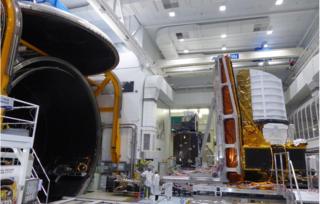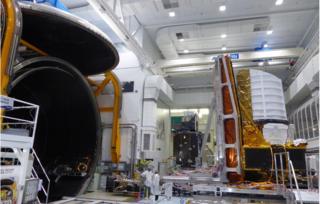Euclid space telescope to study ‘dark Universe’ makes progress

 Image copyright TAS
Image copyright TAS 
Europe’s space mission to uncover the secrets of the “dark Universe” has reached a key milestone.
The test model of the Euclid telescope has just emerged from a chamber where it was subjected to the kind of conditions experienced in orbit.
It was a critical moment for engineers because the successful trial confirms the observatory’s design is on track.
Euclid, due for launch in 2022, will map the cosmos for clues to the nature of dark matter and dark energy.
These phenomena appear to control the shape and expansion of the Universe but virtually nothing is known about them.
The €800m venture, led by the European Space Agency (Esa), will be one of a group of new experiments to come online in the next few years.
Scientists are hopeful these next-generation technologies will provide the insights that have so far eluded them.
The Structural and Thermal Model (STM) of Euclid is a near clone of the real thing, or “flight model” (FM).
To the lay person, it’s actually hard to tell the difference. But the telescope mirrors inside this copy, for example, are unpolished spares, and its “scientific instruments” don’t contain the full complement of components and electronics.
An STM is, nonetheless, a very good representation.
Its job is to run ahead of the FM in the assembly process to find and fix any issues that might arise in the use of materials and the integration of equipment.
“I’ve seen many Structural and Thermal Models in my career and I think this is the most beautiful because it’s actually nearly all made from flight hardware,” Giuseppe Racca, Esa Euclid project manager, told BBC News.
One of the most important stages for the test model is when it goes in a vacuum chamber and is confronted with the challenging temperatures – both hot and cold – that occur in space.
For the Euclid STM, this thermal-vac evaluation was conducted throughout August at a factory in Cannes, France, belonging to Thales Alenia Space (TAS).
TAS leads the industrial consortium that’s building Euclid.
Engineers will now shake the model and blast it with noise to gain the additional assurance that the design can withstand a rocket ride to orbit.
“We should finish the campaign by the end of October and then we will take the lessons learned and apply those to the flight model,” said TAS project manager Paolo Musi.
The observatory is currently running about a year-and-a-half behind schedule. Problems have arisen in a number of areas, but Esa believes the path ahead looks robust.
TAS will spend most of next year assembling the flight model at its factory in Turin, Italy.
Sub-contractor Airbus is putting together the module that contains the mirrors and instruments. The company should deliver this no later than the beginning of 2021.
Another full round of environmental testing follows before the completed observatory is shipped to the launch pad.
Euclid is currently booked to ride a Russian Soyuz into space in 2022, but Esa is now looking closely at the possibility of using Europe’s new Ariane-62 – if it’s available and deemed suitable.
Once in orbit, the observatory will have two major goals.
One is to map the distribution of dark matter, the matter that cannot be detected directly but which astronomers know to be there because of its gravitational effects on the matter we can see.
Galaxies, for example, could not hold their shape were it not for the presence of some additional “scaffolding”. This is presumed to be dark matter – whatever that is.
Euclid will aim to plot its distribution – and discern something of its properties – by looking for the subtle way its mass distorts the light coming from distant galaxies.
Dark energy represents an altogether different problem, and is arguably one of the major outstanding issues facing 21st-Century science.
This mysterious “force” appears to be accelerating the expansion of the Universe. Recognition of its existence and effect earned the 2011 Physics Nobel.
Euclid will investigate dark energy by mapping the three-dimensional distribution of galaxies.
There are patterns in the great voids that exist between these objects that can be used as a kind of “yardstick” to measure the expansion through time.
Euclid is just one in a series of new experiments that will tackle the dark conundrum.
Russia and Germany have just launched the Spektr-RG space telescope which will do a similar job to Euclid but by studying X-ray light in the sky (Euclid will operate in the visible and the infrared).
The American Mid-Scale Dark Energy Spectroscopic Instrument (DESI) is a ground-based experiment due to begin initial operations in the coming weeks. Like Euclid, it will be using the yardstick technique.
And then there’s the Large Synoptic Survey Telescope (LSST). Starting observations in 2020, it will use a range of methods, including mapping exploding stars to measure cosmic expansion.
Isobel Hook from Lancaster University, UK, worked in one of the Nobel-winning teams and is involved in both the Euclid and LSST projects.
“We need to be able to measure the effects of dark energy at different distances and at different times in the history of the Universe. That’s what could reveal something really exciting,” she told BBC News.
“It’s the combination of all these experiments that will give us the maximum amount of information from the one sky that we’ve got.”
Jonathan.Amos-INTERNET@bbc.co.uk and follow me on Twitter: @BBCAmos


